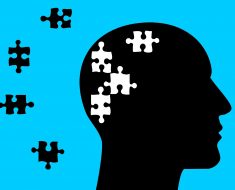Since the pandemic began, the number of people experiencing anxiety has been rising. To ease the immediate symptoms many people have turned to mantra meditation as a relaxation technique. We ask an expert how it works and how to use it effectively.
Welcome to The Curiosity Academy, Stylist’s new learning hub where you can access workshops, how-to guides, new research and learn the most up-to-date skills from the UK’s most in-the-know people.
Anxiety is something many of us experience and it can be incredibly overwhelming. Not only can the mental anguish that accompanies anxiety be a struggle, but there are also physical symptoms that can interrupt our day-to-day lives.
During the coronavirus pandemic, levels of anxiety have been rising. From the pressures of working from home to dealing with isolation and worries about our health, many factors that have surfaced over the last 18 months have had a detrimental impact on our mental health.
A survey conducted by the Office of National Statistics (ONS) found there was a marked increase in anxiety at the beginning of lockdown, with almost half (49.6%) of the people surveyed reporting high anxiety. It also found that average anxiety scores reached 5.2 out of 10 during the pandemic –a substantial rise from 3.0 in the last quarter of 2019.
You may also like
Does mindfulness meditation actually work? One sceptic put it to the test
A further study led by the University of Nottingham and King’s College London and published in the British Medical Journal (BMJ) found that being younger and female was associated with significantly greater levels of stress, anxiety and depression over lockdown.
If anxiety is beginning to get in the way of your daily life, you should always seek professional help. However, many people have turned to relaxation techniques as a short-term solution to ease anxiety-related symptoms.
One of the most popular methods is mantras or the reciting of words or sounds that have a calming effect. Often associated with yoga and spiritualism, mantras is also a secular technique that can be used daily to aid relaxation. It’s also become popular on social media, with more than 4 million people posting about mantras on Instagram.
To find out more about mantra and how it can help relieve some of the symptoms of anxiety, we asked Dr Meg Arroll, chartered psychologist at wellbeing brand Healthspan, what effect mantra has on the brain and how the technique can be used day to day.
What are mantras and how do they it work?
The word ‘mantra’ originates from Sanskrit: ‘man’ refers to the mind and ‘tra’ means release, “hence a method to free tension from the mind,” explains Dr Arroll.
Today, mantras are usually defined as words or phrases which are repeated during meditation practice. It can also refer to a sound or utterance, such as “om”, which is often used in yoga practice.
Affirmations, or positive statements that make us feel joy or empowerment, can also be used as mantras. “Statements like, ‘I allow myself to be who I am without judgment’ or ‘I accept my emotions and let them serve their purpose’, can be used as mantras,” says Dr Arroll, adding that, “anyone can create personalised affirmation mantras to suit their characteristics.”
What effect do mantras have on the brain?
Research has found that mantras can have a positive effect on the brain and our mood.
“Imaging research has shown that during mantra meditation the hippocampus is activated – this area of the brain has important functions in terms of learning and memory,” says Dr Arroll.
“Regarding more immediate effects, mantra meditation is associated with an increase in […] overall sense of wellbeing, as well as reductions in feelings of anxiety and fatigue.”
How to recite mantras
Much of the research into mantras focuses on mantra meditation. According to Dr Arroll, in order to get the most benefit from mantras, it’s best to use it in conjunction with certain aspects of meditation practice such as breathing exercises and finding a quiet, peaceful area to recite mantra.
How to use mantra:
1) Find a space to recite your mantras where you feel comfortable. “This can be indoors or outdoors, wherever you won’t be interrupted for a few minutes,” says Dr Arroll.
2)When you find the right place, sit or lie down so you feel relaxed.
3) It’s best to breathe through your diaphragm when reciting mantras. This will make deep, long breaths easier. “Place one hand on your belly and one on your upper chest – then breathe through your nose, drawing the air down towards your stomach,” says Dr Arroll. “You should feel your belly lift, pushing against one hand while the other on the chest stays still. When exhaling your tummy should dip back down while your chest remains still.”
4) Dr Arroll recommends inhaling like this for a count of three, and exhaling for a count of four.
5) After your breathing is in a comfortable and relaxing flow, recite your mantras either out loud or in your head.
You may also like
Mindfulness alternatives: how to find your inner silence
How to pick the best mantras for you
It’s important to choose a mantra that you feel you can relate to. “Many people find some affirmations such as ‘I radiate beauty, charm, and grace’ rather outdated and at odds with their intention,” says Dr Arroll.
Instead she recommends thinking about what you want to work on with the mantra: “This might be stress management, motivation or boosting your mood.”
Once you’ve decided what aspect of your mood or life you want to focus on, you can align your phrase with your goal or intention. Dr Arroll uses examples such as: “I am calm and grounded within this world” or “My drive and ambition allow me to achieve my goals”.
How to build mantra into your daily routine
To make mantras into a relaxation technique you can easily use day to day, Dr Arroll suggests practising mantras while performing a daily habit that you already do. This could be anything from brushing your teeth in the evening to boiling the kettle for your morning coffee.
“Over time, the association will rub off and your mantra practice will simply be part of your daily routine,” explains Dr Arroll.
If you, or someone you know, is struggling with their mental health or emotional wellbeing, you can find support and resources on the mental health charity Mind’s website and NHS Every Mind Matters or access the NHS’ guide to local mental health helplines and organisations.
If you are struggling, you can also ask your GP for a referral to NHS Talking Therapies, or you can self-refer.
You can also call the Samaritans in the UK on 116 123 or email [email protected] for confidential support.
For more expert-led guides and tutorials follow The Curiosity Academy on Instagram (@thecuriosityacademy).
-
Dr Meg Arroll, chartered psychologist at wellbeing brand Healthspan

Dr Meg Arroll is a chartered psychologist at wellbeing brand Healthspan. Dr Arroll is a chartered psychologist with The British Psychological Society, a chartered scientist with The Science Council and an accredited member of the International Society for Coaching Psychologists.
She started her career in academia, focusing on medically unexplained conditions and now specialises in solution-focused techniques.
Source: Read Full Article





